| 
Introduction /Eye on The Sahara
/Focus on Shelter /Credits
Welcome
to the eighth edition of the Global Eye Primary website.
Global Eye Primary was launched in September 2000 to
complement the Global Eye magazine and website for secondary
schools. The seven previous editions of Global Eye Primary
are still on-line in the ‘Back
Issue Archive’ section of the website.
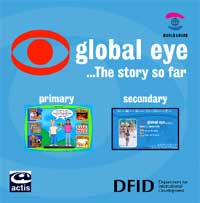 Global
Eye CD-ROM - the story so far Global
Eye CD-ROM - the story so far
Save on internet access and download time
with the CD-ROM of www.globaleye.org.uk!
The CD-ROM allows you to access every edition
of Global Eye Primary up to and including
Spring 2002 on a stand-alone computer or school
intranet system. In addition, the CD-ROM contains
every edition of Global Eye Secondary, providing
a wealth of images and information for you
to download for teaching purposes. Like the
website version, the CD-ROM's 'back
issue archive' section contains an index
that allows users to search for Global Eye
coverage of a developing country or development
theme.
Order
from www.worldaware.org.uk
(Code PA-171) £15.00 (including site
licence) |
|
The aim of Global
Eye Primary is to provide interesting, well-illustrated
and interactive material about developing countries
and global issues to tie in with UK primary curriculum
requirements.
Three characters,
Harry, Cecile and Jack (a parrot) guide pupils around
the website, answering their questions and challenging
them to think about a variety of development issues.
Each section of
the website uses interactive features, key questions
and photos to break down the issues covered into manageable
chunks. The sections of Global Eye Primary are:
The sections
of Global Eye Primary are:
Eye
on a specific case study of a developing country
(or countries) including maps, diagrams, tables, a variety
of photographs and a data file.
Focus
on looks at a development issue and uses case studies
to show how it affects people in developing countries.
On
Camera images from locations in the developing world
with accompanying questions and activities for pupils.
Competitions
prize-winning competitions for individual pupils and
group projects.
top
Click
here
to see details of how the skills and content of the
Global Eye Primary Spring 2003 web pages can be applied
to different subject criteria in the primary curriculum.
There are also references to the National Curriculum
targets in England & Wales.
Please
let us know what you think of Global Eye Primary
and what you would
like to see featured in future editions. We
need your input to help the site
develop and grow. Contact the editor, [email protected] |
|
SUGGESTIONS FOR
SUPPLEMENTARY RESOURCES
Eye
On Sahara
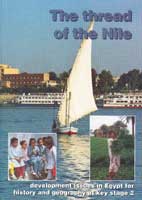 The
Thread of the Nile (Birmingham DEC 1996). The
Thread of the Nile (Birmingham DEC 1996).
Focuses on the importance of the Nile as the lifeline
of Egypt, from ancient history through to present. With
photos and activities. Available from www.worldaware.org.uk
(PA-60 18.00)
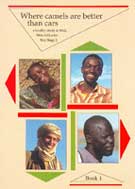 Where
Camels are better than cars (Birmingham DEC 1991) Where
Camels are better than cars (Birmingham DEC 1991)
2 activity books and photos about a village in Mali. Good
locality study. Available from www.worldaware.org.uk
(PA-192 £16.90)
Living on the Line (ActionAid 2000)
For KS3, but has useful information and activities on
the countries on the Meridian line, including Algeria
and Mali. Video and photocopiable pack. Available from
www.worldaware.org.uk
(PA-242 £24.00)
Play on
the Line (HEC Tower Hamlets 2000)
A ‘big book’ for literacy at KS1 with children
from London and refugees from Western Sahara. It explores
play and has teachers notes and activity sheets. Available
from www.worldaware.org.uk
(B-576 £21.00)
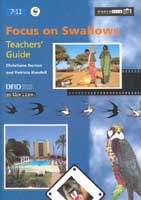 Focus
on Swallows (WWF-UK) Focus
on Swallows (WWF-UK)
This follows the swallow from Europe to Southern Africa,
looking at issues down the meridian line as it goes,
including issues in the Sahara desert. Has a booklet,
twelve A4 size photos and an A-2 poster. Available from
www.worldaware.org.uk
(PA-125 £12.25)
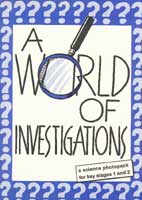 A
World of Investigations (Birmingham DEC 1996) A
World of Investigations (Birmingham DEC 1996)
A Science photopack for KS1 and KS2, using photos to
generate questions, plan investigations and evaluate
outcomes. Looks at different parts of the world including
Egypt. Available from www.worldaware.org.uk
(PA-265 £8.50)
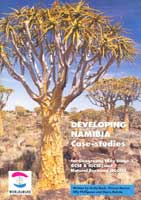 Developing
Namibia (Worldaware 1996) Developing
Namibia (Worldaware 1996)
Although primarily for KS3, this photopack has forty-eight
A4 sized photos that could be used along with the activity
pack for KS2. It examines the geography, economy and
development of Namibia. Available from www.worldaware.org.uk
(PA-104 £10.00)
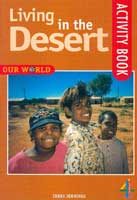 Living
in the Desert (4 Learning 1998) Living
in the Desert (4 Learning 1998)
Includes mapping activities on locating major deserts
and studies of the people who live there, including
some information on the Sahara. Has an information book
and an activity book. Available from www.channel4.com/learning/
(£4.00)
Focus
on Shelter
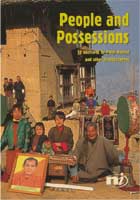 The
"People and Possessions"
postcard book (New Internationalist 2002)provides an
excellent way of using images to compare homes and possessions
in different parts of the world. Each of the 30 postcards
features a family with all their possessions outside
their home. The postcard book costs £4.99 plus
£3.95 postage and packaging per order. Payment
must be enclosed with the order (cheques made payable
to 'New Internationalist' or enclose Visa/Mastercard
details)to: The
"People and Possessions"
postcard book (New Internationalist 2002)provides an
excellent way of using images to compare homes and possessions
in different parts of the world. Each of the 30 postcards
features a family with all their possessions outside
their home. The postcard book costs £4.99 plus
£3.95 postage and packaging per order. Payment
must be enclosed with the order (cheques made payable
to 'New Internationalist' or enclose Visa/Mastercard
details)to:
New Internationalist
PO Box 61
Goldthorpe Industrial Estate
Rotherham S63 9YG
UK
Or Fax: 01709 881673
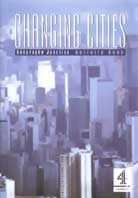 Changing
Cities Changing
Cities
Looks at many aspects of life in cities but has a good
section on sustainable homes, environmental change,
and community. Teacher notes and activities. Available
from www.worldaware.org.uk
(B-401. £7.65)
Changing
Cities Video (Channel 4 Learning 1999/2000)
Five fifteen minute programmes on Cajamarca, Peru, Calcutta,
India and Sao Paulo illustrating environmental change
and management. Available from www.worldaware.org.uk
(V-13 £16.50)
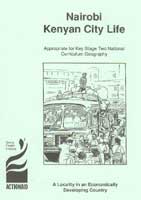 Nairobi,
Kenyan City Life (ActionAid 1992) Nairobi,
Kenyan City Life (ActionAid 1992)
Portrays the life of a poor community in a slum area
of Nairobi, Kenya. Includes A4 size photos, maps, background
information, teacher’s notes and activities. Available
from www.worldaware.org.uk
(PA-190 £20.00)
Primary Poster Packs - Cities (Oxfam 2000)
Poster pack about cities and different housing and people
who live there. Available from www.worldaware.org.uk
(PA-224 £16.25) http://www.stepin.org/menuframe.asp?passpage=2
shows self-help housing in Kenya with the Masai. It
shows how they overcome problems and build houses that
aim to be sustainable. Clear sections, although the
activity at the end may be less appropriate for KS2
as the focus is specifically on design and technology.
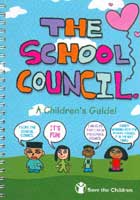 The
School Council (Save the Children 1999) The
School Council (Save the Children 1999)
This guide introduces the idea of children forming their
own school council. It features children’s own
words and artwork and is a step-by-step guide to all
the stages of a school council. Available from www.worldaware.org.uk
(B-500 £6.00)
‘We, the World’ (Survival International
2000)
This is an informative pack that has an A1 poster, three
A3 posters (one on Yanomami and on two other tribes),
letters, activities and detailed information. Available
from www.worldaware.org.uk
(PA-236, £2.50)
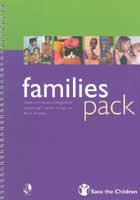 Families
Pack (Save the Children 2002) Families
Pack (Save the Children 2002)
Takes four children’s viewpoints and stories about
where and how they live in different parts of the world,
and includes photo sheets, activities and a teachers
book. KS1 and KS2. Available from www.worldaware.org.uk
(PA-255 £17.00)
CREDITS
The Global Eye Primary website, Summer 2003 was
written by Catherine Stocker and edited by Simon Scoones
for Worldaware.
Contributions and assistance from:
Pat Trussell
Sarah Lewis, Survival International
Photographs: Panos
Pictures, Rex Pictures, Still Pictures, Survival, Simon
Scoones/Worldaware, Catherine Stocker/Worldaware.
Worldaware
Echo House
Ullswater Crescent
Coulsdon
Surrey CR5 2HR
Tel: 020 8763 2555
Fax: 020 8763 2888
www.worldaware.org.uk
E Mail (General Enquiry): [email protected]
E Mail (Global Eye): [email protected]
top |